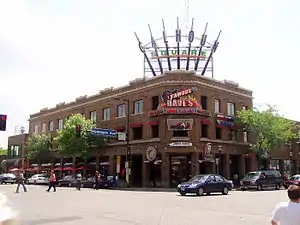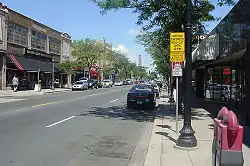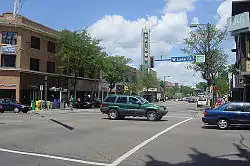Uptown, Minneapolis
Uptown is a commercial district in southwestern Minneapolis in the U.S. state of Minnesota, that is centered at the Uptown Theater (the former Lagoon) at the intersection of Hennepin and Lagoon avenues. It has traditionally spanned the corners of four neighborhoods, Lowry Hill East, East Calhoun, South Uptown and East Isles neighborhoods, which are all within the Calhoun Isles community.[2] Historically, the boundaries of Uptown are Bde Maka Ska to the west, Dupont Avenue to the east, 31st Street to the south, and 28th Street to the north. Uptown is a popular destination for retail, nightlife, and cultural events, and the district was famously written about by recording artist Prince.[3]
Uptown Minneapolis | |
|---|---|
Commercial District | |
 Seven Points (Minnesota), formerly known as Calhoun Square, has been at the center of Uptown since the 1980s. | |
| Motto(s): "Normally out of the ordinary"[1] | |
 Uptown is within the Calhoun Isles community of the U.S. city of Minneapolis | |
| Coordinates: 44°56′56″N 93°17′55″W | |
| Country | United States |
| State | Minnesota |
| County | Hennepin |
| City | Minneapolis |
| Community | Calhoun Isles |
| Branded | 1920s |
| Founded by | Uptown businessmen created "Uptown" name for area |
| Named for | Desire to create an Uptown-like district similar to Chicago |
| Time zone | UTC-6 (CST) |
| • Summer (DST) | UTC-5 (CDT) |
| Area code(s) | 612 |
History
The Lakes Area of Bde Maka Ska, Lake Harriet, and Lake of the Isles became popular in the 1880s as vacation cottages, hotels, and boating recreation became available by streetcar. As Minneapolis expanded south, housing construction boomed through the 1920s. A commercial district began forming just east of the Lakes Area. At the intersection of Hennepin Avenue and Lagoon Avenue, the Lagoon Theatre was built, a multi-function vaudeville theater. When the Lagoon burnt down in 1939, owners sought to rebuild and the business community took the opportunity to rebrand the area.[4] Following the success of Chicago's Uptown District, the Minneapolis Tribune announced the new Uptown District of Minneapolis[5] centered on the newly renamed Uptown Theatre.

Through the 20th century, Uptown was primarily a family area centered on nearby West High School at Hennepin and 28th Street West. Modest housing along Lowry Hill met the mansions of Kenwood to the west and around the lakes. Hennepin flourished as a commercial corridor and route from downtown to residential homes, while Uptown served also as an important streetcar route from Uptown to the vacation homes of Lake Minnetonka. White flight via the freeway system after World War II and demolition of West High School signaled a demographic shift in the area. Blight and crime began moving into Lowry Hill though were kept at bay by the Kenwood area. Neighborhood associations and formal borders were designated in the 1970s as each section of Uptown began addressing domestic problems.


During this time, Uptown developed an artist culture. The history of this culture is preserved in the annual Uptown Art Fair. In 1980, Minneapolis musician Prince, a graduate of Central High School, released his seminal recording Dirty Mind, which contained his paean to these artists, appropriately titled "Uptown". In the 1990s he later owned a store at 1408 West Lake Street called New Power Generation. A retail renaissance of the area occurred in the 1980s when Seven Points (formerly named Calhoun Square) was developed. Combining a half block of existing storefront buildings, the renovation turned the area into a competitive retail draw from Downtown and from the suburban dales (malls). As the popularity of Uptown as a residential district grew again, the definition of the area expanded.
The Lake Street Council launched a Museum In the Streets project, a series of free, self-guided walking tours highlighting business districts along Lake Street, including Uptown. The Uptown Tour spotlights historic businesses and places in the neighborhood, including the origins of Abdallah Candies, Schatzlein Saddle Shop, Schlampp & Sons Furriers, and the Uptown Theater.[6]
Culture
Uptown is a mix of various cultural strains and is considered an area for young people to live and shop. It was formerly known as a vibrant center for artists and musicians, a center for Counterculture, and hippies, similar to East Village, Manhattan. The artist community was popularized by the musician Prince, who started his career in Uptown. The area has experienced gentrification, and is no longer considered the bohemian area it once was. Many of the older buildings and long-standing businesses in the area have closed or been torn down due to gentrification. But the area is still considered vibrant and walkable.[7]
This area has a vast variety of ethnic food and grocery stores from Asian to Mexican to middle eastern. Uptown's more than 20 bars within a three-block radius draw people from across the metro area to revel in the district. Uptown seems to draw a "slightly older and 'more sophisticated'" clientele compared to the Warehouse District. Controversy about noise, particularly surrounding bar's rooftop patios. In 2011 City Council Member Meg Tuthill wrote a noise ordinance to address the issue, but it was afterwards withdrawn.[8]
The area annually hosts the Uptown Art Fair, during the first full weekend of August. Local, national, and world artists converge to exhibit and sell fine art. Art media include paintings, sculptures, clothing, pottery, jewelry, glass, and mixed media.
Demographics
As of 2000 the current population for Uptown Minneapolis was 30,564 of which 15,947 are male and 14,617 are female. The population consists of 19,314 Caucasians, 4,930 African-Americans, 4,729 Hispanics, 1,630 Asians, 514 Native Americans, and 32 native Hawaiian. Fewer than 3,600 of this population are children under 5 and citizens over the age of 65. The median age is 29 years old. The majority age of this area is people 18 years and older. The average household size is 2.05 while the average family size is 3.19. Uptown Minneapolis has a total of 15,033 housing units of which 75% are renter occupied while 3% of housing units were vacant. Social characteristics showed 40.08% of population completed a bachelor's degree or higher while 84.9% had completed a high school degree or higher. The median household income is $34,216.00, the median family income is $38,634.00.
Economy
Uptown is renowned for its lively arts and entertainment options that feature many restaurants, stores, night clubs, bars, and theaters.[9] In the 2000s, however, the neighborhoods surrounding Uptown have seen a surge in gentrification. This has caused an increase in property value and in property taxes.[10]
Transportation
The Uptown Transit Station is located on Hennepin Avenue over the 29th Street Greenway and serves Metro Transit buses 6, 12, 17, 21, 23, 53, 114 and 115. The station also has a change machine, a heated interior, binoculars, bike lockers and posts, and a workers lounge and office area. The Midtown Greenway, a former railway cutting which now hosts a bike path, bisects Uptown roughly a block north of Lake Street (where 29th Street would otherwise have been located). To improve the ease of transportation in a community that is currently pedestrian heavy, Hennepin County is considering the addition of a streetcar in the Greenway.
Notable residents
- Lyle Wright, businessman and hockey manager
References
- MN Monthly Review of Uptown
- Imboden, Thatcher; Phillips, Cedar Imboden (2004). Uptown Minneapolis. Arcadia Publishing. ISBN 0-7385-3358-0.
- "Uptown Grows Up". mspmag.com.
- http://www.landmarktheatres.com/market/Minneapolis/UptownTheatre.htm
- "Good Questions: Mosquito Food, Uptown, Hat Tricks". CBS Minnesota. July 10, 2015. Retrieved July 11, 2015.
- "Uptown Tour - Lake Street Council". www.lakestreetcouncil.org. Retrieved October 27, 2015.
- Uptown personality crisis accessed March 30, 2015
- "Uptown's late-night scene is hitting a new high". Star Tribune.
- "The Best of Minneapolis' Uptown Neighborhood". Meet Minneapolis. Retrieved October 24, 2020.
- Minnesota Public Radio (September 30, 2005). "MPR: Minneapolis losing affordable housing to condo conversions". publicradio.org.